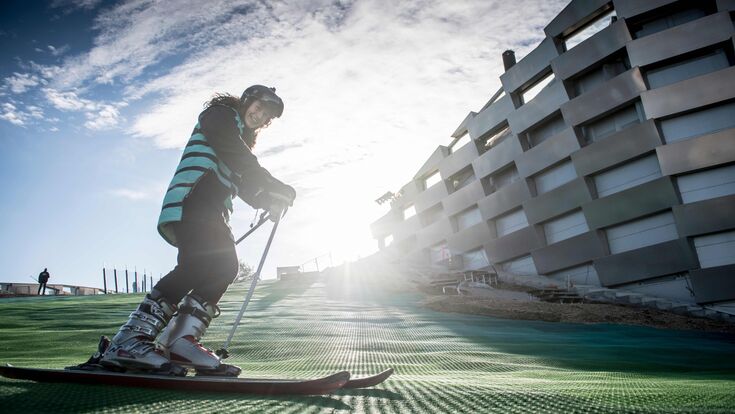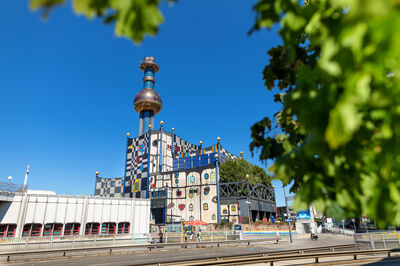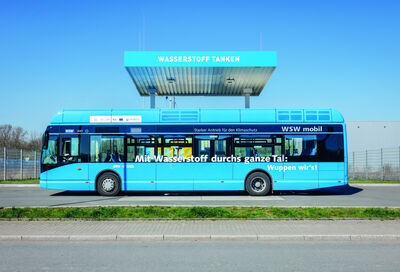Waste to Energy : Thermal Recycling: Not in my Backyard?

The Queen of Denmark is amused. Every morning when Margrethe II looks out of the windows of Amalienborg Palace, she sees the chimney of Amager Bakke. This has now become a familiar and much-loved sight. Located in the centre of Copenhagen, with a ski slope on its roof, hiking trails, the world’s highest artificial climbing wall and a mountain bike trail, the waste incineration plant – which was completed in 2017 and has an annual capacity of 400,000 tonnes – has very quickly become a new landmark in the city. And a tourist attraction. Special plastic mats enable visitors to ski here, at sea level, all year round. It doesn’t feel much different to skiing on snow.
Around 900 km further south, in Vienna, stands another landmark: Spittelau waste incineration plant, designed by the versatile Austrian artist, architect and environmental pioneer Friedensreich Hundertwasser. The façade of the building is, in typical Hundertwasser style, decorated with countless irregular and colourful shapes and textures. The chimney is somewhat reminiscent of the tower of an Orthodox church. Inside, some 250,000 tonnes of waste a year are turned into electricity and district heating.
Viennese charm
Spittelau and Amager Bakke are two examples of how incineration can be successful, not just from a technical point of view, but also – and above all – in socio-political terms. Both plants have established themselves not just as real tourist magnets; more importantly, from the perspective of their operators, they are widely accepted by the public. “Vienna really is a city where the inhabitants support an integrated waste management concept. And there’s consensus that this also includes thermal recycling as well as waste prevention and recycling,” says Martina Ableidinger, Head of Communications at the municipal department responsible for waste management in Vienna.
Before municipalities can be in this kind of comfortable position, however, a lot of effort needs to go into convincing people. As well as long-term strategic thinking. Vienna, for instance, draws up a waste management and prevention plan every six years and tries to involve all important stakeholders in the process: politicians, experts and environmental groups. Outlining the experiences gained, Ableidinger says: “This has enabled us to reach agreement on important projects in Vienna during the planning stage and to prevent subsequent protests. One example is the construction of Vienna’s third waste incineration plant, Pfaffenau, which was opened in 2008.” Incidentally, the initial preparations for building the Pfaffenau plant began around ten years before construction started.
Like what you read? Stay up-to-date with our newsletters!

Successful operators actively approach opinion leaders, win over local communities with facts and incentives, and regularly seek dialogueElla Stengler, CEWEP
Kristel Moulaert can also confirm that it takes time to convince people. As Managing Director of the intermunicipal waste management organisation ISVAG, formed by the Belgian municipalities of Antwerp, Mortsel, Boom, Puurs, Niel and Hemiksem, Moulaert is currently making sure all the arrangements are in place so that Antwerp’s old waste incineration plant, which was planned in 1975, can be replaced by a new building by 2027.
More on the topic: Waste-to-Energy in a Circular Economy: Friend or Foe?
A long haul
The six years she has will be just about enough time. Although actually, everything is already clear. Despite all the waste prevention and recycling efforts, the volume of household waste in Antwerp that cannot be recycled remains constant, at around 183,500 tonnes per year. The old plant has reached its limit and it would be virtually impossible to upgrade it. The new building, on the other hand, will not only facilitate state-of-the-art technology, but will also drive the expansion of the district heating network and thus contribute to achieving the climate targets. Moreover, the new plant will even be prepared for developments that are currently still far from market maturity, such as carbon capture technology.
Technical facts alone will not create acceptance, however, no matter how impressive they may be – and nor will mere figures. “That’s why we try to work very hard with comparisons in our external communications,” explains Moulaert. “Usually only technicians can make sense of abstract emission values. But if we show that burning the waste of one million people in our plant generates as much particulate matter as heating 48 households with a wood or pellet fire in an annual comparison, then it becomes clear to ordinary people how clean our technology actually is.”
In addition, ISVAG has created an independent and international pool of experts to assess its plans. Their task was first to examine the existing plans for alternatives and, wherever feasible, to work out ways of implementing these. The idea behind this was to ensure that no one objecting to the project would be able to say there would have been an environmentally or economically better solution that the operators hadn’t considered.
Eight steps to increase Acceptance
Global lessons on how waste-to-energy projects can become success stories
- Create transparency and openness. Offer guided tours for local residents, schools and decisionmakers.
- Get as many stakeholders on board as possible.
- Demonstrate transparency. Post your emission data online in real time, for example.
- Show social commitment. In the Lithuanian city of Klaipéda, the waste-to-energy operator sponsors both a kindergarten and a local basketball team.
- Talk to opinion leaders, including those in the digital world (aka influencers).
- Show that incineration is part of a programme and that you are not competing with material recycling, composting and waste prevention, but complementing them.
- Turn incineration plants into attractive destinations. In Copenhagen, visitors can even ski on the roof.
- Create an impressive building with a unique design and architecture - examples from Kraków and Vienna show how it is done.
All questions answered
The pool of experts now provides local residents, politicians and environmental activists with reliable answers to even the most unusual questions. “We usually respond to inquiries within an hour. If we do not know the information, we write that we will answer the mail as soon as possible and contact our experts,” says Moulaert.
Independently of this, however, ISVAG also proactively approaches the public by holding events such as guided tours, open days and information sessions. The organisation also reaches out to politicians: “Very few politicians have a technical education,” says Moulaert. “Nevertheless, when they meet with voters, they are always confronted with questions about the new construction of our plant. We want them to give good, well-founded answers. That not only helps us, but also them.”
Actively approaching opinion leaders, winning over local communities with facts and incentives, and regularly seeking dialogue are important strategies according to Ella Stengler, Managing Director of CEWEP, the Confederation of European Waste-to-Energy Plants. Stengler maintains that as a rule, municipalities and operators that pursue these strategies ultimately succeed in creating a good climate for their projects.
That said, the objections against which they have to defend themselves are all too often irrational. These include the persistent conviction that incineration causes lockin effects and hinders both material recycling and waste prevention. In reality, however, the effects are quite different, says Stengler. Wherever waste to energy is used, not only does the use of landfill decline, but more material recycling is carried out at the same time. “That’s logical. Incineration requires a well-developed, reliable collection system up front. Where such a system exists, it’s also easier to separate individual fractions and recycle them materially.”
There needs to be a consensus that a waste strategy also includes thermal recycling as well as waste prevention and recycling.Martin Ableidinger, Vienna waste management
Criticism of the EU
The figures are revealing. With a high waste-to-energy rate of 42%, the Netherlands simultaneously has a very high recycling and composting rate of 57%. In Romania on the other hand, where only 5% of waste is thermally treated, the recycling and composting rate is also low at just 12%. What happens to a further 7% is unknown, and a huge 76% of waste ends up in landfill.
Stengler is therefore very critical of the fact that incineration has not been included in the EU’s Green Deal taxonomy, which lists the technologies that are considered to be sustainable and which should therefore receive funding. In future, she says, this will make it particularly difficult for poorer EU countries to fund waste-to-energy projects and move away from large-scale landfilling.
This is a view shared by Christophe Cord’homme, Development Director at French equipment manufacturer CNIM. “On the one hand, how does the EU intend to reduce landfill to less than 10% if at the same time it makes it more difficult to finance waste-to-energy plants?” he asks.
Apart from that, he adds, many public discussions ignore the fact that there will never be a perfect circular economy linked to a utopia of zero waste and infinite recycling without needing any energy or decontamination. “There will always be the need to have waste to energy as a safe final sink for polluted waste that can no longer be recycled. Whoever denies this probably also believes in the myth of perpetual motion.”
The energy aspect also needs to be emphasised much more in discussions about thermal recycling. After all, thermal recycling at least allows the energy contained in discarded products to be recovered, most of which is renewable energy. Instead of preventing thermal recycling, Cord’homme believes that Europe would be well advised to create a framework enabling countries that are less advanced in terms of waste management to make the transition from landfilling to obtaining energy from non-recyclable materials.
Acceptance through fiscal pressure
In Great Britain, for example, he explains, acceptance of thermal recycling has been achieved partly through fiscal pressure. When it came to getting local authorities and companies to recycle their residual waste thermally instead of sending it to landfill, an important but progressive increase in landfill prices (via taxation) was announced: an increase of 10% per year over ten years. Everyone could then calculate when landfilling would no longer pay off and switch over in time. The end result spoke for itself: the landfill share in the UK has fallen from 70% to 17% since 2000 and has been replaced by a mix of resource-from-waste facilities, which recover both material and energy.
And another point needs to be communicated even more strongly to policy-makers, consumers and citizens: the fact that thermal recycling nowadays has nothing to do with the dioxin scandals or open burning on the street experienced in the past, which is occasionally still seen in the odd place today. Quite the opposite, in fact: there are few sectors that have to meet stricter emission requirements than the waste industry.

This is also underlined by Johnny Stuen, Production Director at the Agency for Waste Management in the Norwegian capital of Oslo. “From a technical point of view,” he says, “energy recovery of residual waste is at a very high level, and the so-called advanced thermal treatment technologies will probably not lead to either lower emissions or a better energy yield. So I don’t think we’ll see much change here in the next 20 to 30 years.” With even better filters and with carbon capture systems, he says, the emissions balance could be improved even further, but basically there is only room for small optimisation steps.
“If material recycling is not possible and we don’t have clean monostreams, but mixed material, incineration is the best solution,” emphasises Stuen, and then adds self-critically: “I sometimes think this very essential point is lost in discussions about incineration. We should communicate it much more forcefully.”
If the EU Commission has its way, thermal recycling will be prevented from using the label ‘sustainable’. At least, this is set out in the current delegated act of the Taxonomy Regulation, a key element of the new Green Deal. Technologies that are not explicitly identified as green in the taxonomy will be in a weaker position when it comes to bank loans and also funding.
The idea behind this is simple, possibly too simple: if waste incineration can no longer be funded, the Commission imagines that countries and municipalities will have to find other ways of processing waste. In theory, this will lead to even more recycling, even more waste prevention, and to new and improved methods of disposing of any remaining residual waste.
If material recycling is not possible and we don’t have clean monostreams, but mixed material, incineration is the best solution.Johnny Stuen
In practice – and it is no coincidence that this objection is being raised by practitioners – the regulation will create a disastrous lock-in effect as far as landfills are concerned, especially in countries that have not yet developed a waste incineration infrastructure. In the south of the EU – and not just there – there are plenty of these: in Greece, 78% of household waste is still sent to landfill; in Romania, 76%; in Cyprus, 67%; and as much as 92% in Malta.
Already being used successfully in Scandinavia, Germany and Austria, thermal recycling would be a way of achieving more waste separation, and thus automatically more material recycling too, through the upstream collection systems. And a way of disposing of the remainder as safely as possible (while still recovering energy in the process). If building the associated infrastructure becomes financially impossible, however, poorer countries will be forced to continue landfilling on a large scale.
The EU doesn’t want that to happen either, of course. It has therefore announced a target to reduce the proportion of waste sent to landfill to no more than 10% by 2035. But there’s one thing that Brussels isn’t saying: where countries without the option of thermal recycling should send their waste that is not suitable for material recycling. To illegal landfills in the forest?
Update: Recent legal developments
As part of the European Green Deal, the European Commission also wants to change some aspects of the EU Emissions Trading System (ETS). One such aspect is including waste to energy in the trade system. Last June the European Parliament approved the inclusion of municipal incinerators in the scope of the EU ETS as of 2026. But the European Council is calling for a prior conditional impact assessment. “Such an assessment is also crucial in the absence of a clear EU framework for the monitoring and reporting of emissions that fits the specific features of waste incineration,” says Patrick Clerens, Secretary-General of ESWET (European Suppliers of Waste-to-Energy Technology).
On April 15th, MEPs and EU governments agreed to reform the Emissions Trading System. This now means that EU countries will have to measure, report and verify emissions from municipal waste incinerators from 2024. By 31 January 2026, the Commission shall submit a report with a view to including such installations in the EU ETS from 2028, with a potential opt-out until 2030 at the latest.
The article was originally posted on April 29, 2021

